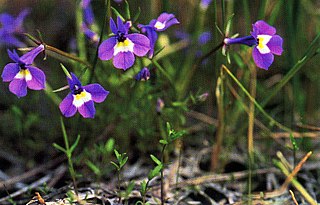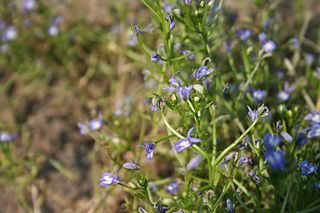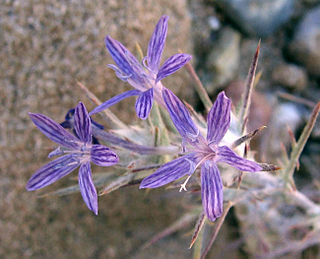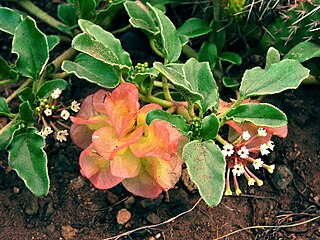
Downingia bella, also known as Hoover's calicoflower or Hoover's Downingia, is a member of the Bellflower Family (Campanulaceae). The genus is named after A.J. Downing (1815–1852) a noted American horticulturist and landscape architect.

Delphinium depauperatum is a species of larkspur known by the common names slim larkspur and dwarf larkspur. This wildflower is native to western North America where it is found in mountain meadows. It grows from a short root and erects a stem usually under 40 centimeters in maximum height. The small leaves are divided into lobes and are usually located about the base of the plant. Toward the top of the stem are flowers on long pedicels, with usually not more than 20 flowers per plant. The flowers generally have deep dark blue sepals which are flat and extended to the sides, and petals which are mainly the same color except for the top two, which may be lighter blue to white. The spur is between one and two centimeters long.

Downingia bicornuta is a species of flowering plant in the bellflower family known by the common name doublehorn calicoflower and double-horned downingia. This showy wildflower is native to the western United States from California to Idaho, where it is a resident of lakesides and vernal pool ecosystems.

Downingia concolor is a species of flowering plant in the bellflower family known by the common names maroonspot calicoflower and fringed downingia. This showy wildflower is endemic to California, where it is a resident of ponds and vernal pool ecosystems in the northern part of the state.
Downingia cuspidata is a species of flowering plant in the bellflower family known by the common name toothed calicoflower. This showy wildflower is native to California, where it is a resident of ponds, meadows, and vernal pool ecosystems throughout the state. Its range may extend into Mexico.

Downingia elegans is a species of flowering plants in the bellflower family known by the common names elegant calicoflower and Californian lobelia. This showy wildflower is native to western North America from California to British Columbia, where it is a resident of meadows and vernal pool ecosystems. This annual grows on a branching erect stem with many pointed leaves. At the top of each stem branch is one or more flowers, each one half to two centimeters wide. The tubular flower has two long, narrow, pointed upper lobes which are generally rich purple. The lower lip is fused into one three-lobed surface, which is purple with a large blotch of white in the center. The lobes may be quite pointed. There is sometimes some yellow coloration near the mouth of the tube.
Downingia insignis is a species of flowering plant in the bellflower family known by the common names harlequin calicoflower and cupped downingia. This showy wildflower is native to the western United States from California to Idaho, where it is a resident of lakesides and vernal pool ecosystems.

Downingia laeta is a species of flowering plant in the bellflower family known by the common name Great Basin calicoflower. This showy wildflower is native to western North America from California to Saskatchewan, where it is a resident of riverbanks, ponds, and vernal pool ecosystems. This annual grows on a thick erect stem with a few short, pointed leaves. Atop the stem is usually a single flower, which has an upper lip made up of two narrow, pointed lobes in shades of very light blue or purple, or white, and a lower lip which is a fusion of three lobes in the same color with two bright yellow spots and sometimes some purple or pink blotches or streaking.
Downingia montana is a species of flowering plant in the bellflower family known by the common name Sierra calicoflower. This showy wildflower is native to California, where it lives in the meadows and pine forests of the high mountains. Its range may extend into Oregon. This annual grows an erect stem, which may branch or not, with a few sparse small, pointed leaves. Atop the stem is usually one tubular flower. The upper lip is made up of two narrow, pointed lobes usually a shade of lavender, and the lower lip is the same color, with a central field of white and two prominent projections which may be colored yellow and dark purple. The lower lip has three lobes, each of which may have a tooth. The fruit is a capsule one to four centimeters long.
Downingia ornatissima is a species of flowering plant in the bellflower family known by the common name folded calicoflower. This showy wildflower is endemic to California, where it is a resident of vernal pools and other wet places in the Central Valley. This annual grows an erect, branching stem with usually one tubular flower at the top of each branch. The flower has an upper lip made up of two narrow, pointed lobes in shades of light purple, and a lower lip made up of three lobes fused into one surface, which is the same color as the upper lip and has a central field of white with two prominent yellow projections. The flower is similar to those of other downingias, except it is lightly crinkled, with the upper lobes often curled back and the edges of the lower lobes uneven. The dark blue anther just emerges from where it is tucked between the upper lobes.

Downingia pulchella is a species of flowering plant in the bellflower family known by the common names flatface calicoflower and valley calicoflower. This showy, annual wildflower is endemic to California, where it is a resident of vernal pools and other wet places in the central part of the state from the Tehachapi Mountains to the San Francisco Bay Area.
Downingia pusilla is a species of flowering plant in the bellflower family known by the common name dwarf calicoflower. This wildflower is found in two separate parts of the world, Chile and the US state of California. It grows in wet areas such as ditches and vernal pools. This annual is different from the other downingias in that its flowers are much smaller, reaching 4 millimeters in width at maximum. It grows erect stems with few pointed leaves. The tiny tubular flower is white or blue, with yellow spots near the mouth of the tube. The fruit is a capsule two or three centimeters long.

Eriastrum densifolium is a species of flowering plant in the phlox family known by the common name giant woollystar. This wildflower is native to California and Baja California where it grows in open areas such as sand dunes and dry washes. It grows on an erect stem with slightly hairy to densely woolly foliage, often giving the plant a dark gray-green color. The leaves are narrow and spike-shaped with pointed lobes. The top of each stem is occupied by a bunched inflorescence full of woolly leaflike bracts and funnel-shaped, flat-faced flowers. The flowers are each 1 to 3 centimeters long with a face up to three or four centimeters wide. The lobes are white to bright, striking blue, sometimes with longitudinal pinstripes. The stamens protrude from the throat.

Gilia clivorum is a species of flowering plant in the phlox family known by the common names purplespot gilia and many-stemmed gilia. It is native to California and Arizona.

Crepis modocensis is a species of flowering plant in the family Asteraceae known by the common name Modoc hawksbeard.
Perideridia bacigalupii is an uncommon species of flowering plant in the family Apiaceae known by the common names Mother Lode yampah and Bacigalupi's perideridia. It is endemic to California, where it is known only from the northern and central Sierra Nevada foothills. It is a member of the flora in chaparral and pine woodlands. It is a perennial herb which may exceed 1.5 meters in maximum height, its slender, erect stem growing from tubers. Leaves near the base of the plant have blades up to 40 centimeters long which are divided into many narrow subdivided lobes. Leaves higher on the plant are smaller and less divided. The inflorescence is a compound umbel of many spherical clusters of small white flowers. These yield ribbed, oblong-shaped fruits about half a centimeter long.

Porterella is a monotypic genus of flowering plants in the bellflower family containing the single species Porterella carnosula, which is known by the common name fleshy porterella, or simply porterella.

Silene menziesii is a species of flowering plant in the family Caryophyllaceae known by the common names Menzies' campion and Menzies' catchfly. It is native to western North America from Alaska through the western half of Canada to the southwestern United States. It can be found in many types of habitat and it is quite common in much of its range. It is variable in morphology and there are a number of varied subtaxa. In general, it is a perennial herb growing from a caudex, appearing matlike, decumbent, or erect, with stems a few centimeters to over half a meter long. It is usually hairy in texture, with upper parts bearing sticky glandular hairs. The leaves are lance-shaped, oppositely arranged in pairs, and a few centimeters in length, upper leaves usually smaller than lower. Flowers may occur in a cyme at the top of the stem, or in leaf axils, or both. Each is encapsulated in a hairy, veined calyx of fused sepals. The petals are white with two lobes at the tips. The plant is dioecious with male and female plants producing different flowers. The male and female flower types look the same externally; the stamens are reduced in female plants and the stigmas are reduced in the male.
Silene nuda is a species of flowering plant in the family Caryophyllaceae known by the common names western fringed catchfly and sticky catchfly.

Tripterocalyx micranthus is a species of flowering plant in the four o'clock family known by the common names smallflower sandverbena and small-flowered sand-verbena.













